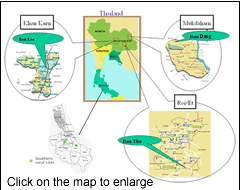|
THAILAND
The WeD research in Thailand addresses the
rapid transformation of Thai society which the country has been
experiencing over the last three decades. In particular it asks
how this can be considered to have contributed to the wellbeing
of all of its people? Although compared with the other three WeD
research countries, Thailand has the highest per capita income,
its strong economic growth and high incomes have been accompanied
by a remarkable persistence in the inequality of the distribution
of income. The WeD study focuses in two distinctive regions of
the country. The Northeast is often acknowledged as the poorest,
while the South, generally, has fared well and is a relatively
prosperous area. Within each region, however, there is diversity
and the WeD research is designed to explore that. In both areas,
the study is concerned to capture the distinctiveness of the ways
in which people construct their wellbeing.

In the Northeast, the research project is based in
the Faculty of Humanities and Social Sciences, of Khon Kaen University,
while in the South it is based in the Faculty of Natural Resources
at the Prince of Songkla University. In both centres the research
teams comprise of a range of experts from different disciplines
including sociology, economics, urban studies, public administration,
health and population studies, and development studies.
Rural study sites
Three rural suites have been selected in both the Northeast and
South:
- Ban Lao (Northeast - Khon Kaen Province)
is about 15 kilometres away from Khon Khaen town. Although agriculture
remains prominent, a great number of people are involved in off-farm
activities,
such as working in factories and on construction sites. This
village has good infrastructure and is well-connected to the
thriving
economy of Khon Kaen town.
-
Ban Tha (Northeast - Roi-Et Province) is
surrounded by a rich variety of natural resources. Most of
the households in this village are rice farmers, but they also
earn
their livelihoods from the exploitation of other natural resources,
as well as migrating to work in modern sectors of the economy.
This village is moderately well connected to modern urban centres.
-
Ban Dong (Northeast - Mukdaharn Province)
is located in the middle of Phu Phan Mountain range and is
distant from Mukdaharn Provincial town. The village is
located in
a national park, and consiquently the villagers have
no property rights in land. Currently their livelihood strategies
depend on a mixture of cash cropping (cassava), cattle raising,
exploitation of forest products, and migration. This village
is a relatively remote community in modern Thailand.
-
Ban Thung Nam (South - Songkhla Province) was
established over 50 years ago. Altogether there are over 300
households with the proportion of Thai Muslims and Thai Buddhists
being about 70:30.
Occupations include rubber production, rice production, animal
raising, fruit production, hired labour in rubber plantation
and labouring in nearby factories. The village is considered
moderately remote with roads from the village of
poor quality.
-
Ban Chai Khao (South - Songkhla Province) is
a large rural community located on the outskirts of Hat Yai
city.
While it is near a large city, much of its economic activity
is still dependent on rubber plantantions and other forms of
agriculture. This juxtaposition of agricultural-rural and the
modern-urban is
increasingly
unusual
in Thailand. Its ethnic composition features an equal proportion
of Thai Buddhists and Thai Muslims. Access to all government
facilities is very good for the community due to its peri-urban
location.
Urban Sites
In Thailand the focus of the urban studies are two rapidly growing
provincial centres. Khon Kaen in the Northeast and Hat Yai in
the South. In Thai studies, the problems related with urbanization
have primarily concentrated on Bangkok, but there has been significant
urban growth in the provinces. Khon Kaen and Hat Yai are two
growing and thriving cities and in both areas combine 'slums'
and more settled communities, Klai Talaad in the South and Nai
Muang in the Northeast, have been identified as focal points
for the
research.
See also country site at www.wed-thailand.org
|










